Splinterlands 🐉| Ruleset Rumble - What’s my Fog of War Strategy? 🤔 [EN/PT]
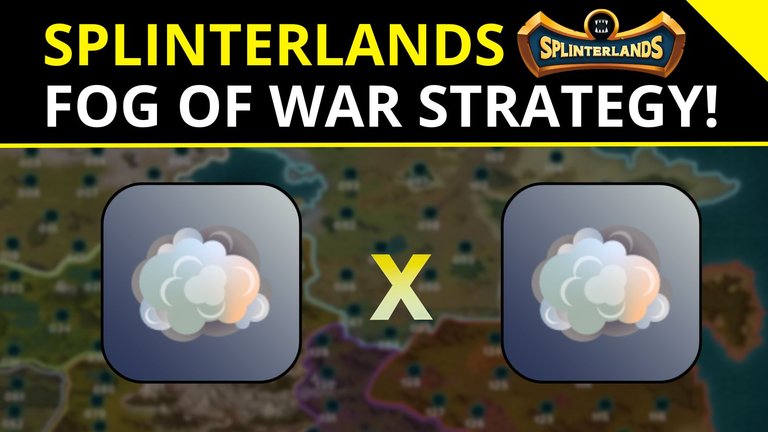
Splinterlands holds a weekly event called the Community Engagement Challenge, which aims to encourage players of this NFT card game to comment on a specific topic, sharing their perspectives with the rest of the community. This week's theme is #RulesetRumble. Unlike past events, which focused on a specific ruleset, this one allows players to choose between: Fog of War, Little League, or Up Close & Personal.
We'll cover the details of the strategy used in the Fog of War rule, which was chosen for this event, and then a practical example of a match using this rule, analyzing my team and my opponent's. Come find out now!
I'll be much appreaciated if you Upvote, Reblogs or give any Tips ( PIZZA 🍕, PGM 🎮, LOLZ 😆, ALIVE ❤️, etc ). Thanks and have good reading! 🍀

[ENGLISH VERSION]
Strategy vs. Fog of War
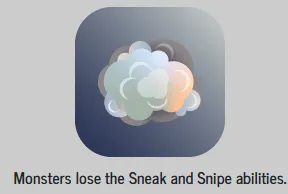
As an initial context, we should fully understand the "Fog of War" ruleset. When this rule is active in the game, all monsters with Sneak and Snipe lose these abilities, leaving only monsters with Opportunity as a threat to be considered. When faced with a situation where this ruleset appears, such as the number of monsters attacking the team's backline or midline is drastically reduced, the best strategy for the player is to choose a great tank, spend enough mana to add a tank capable of withstanding a good amount and variety of damage (melee, ranged, and magical) to the lineup, because attacks will be largely concentrated on your team's frontline.
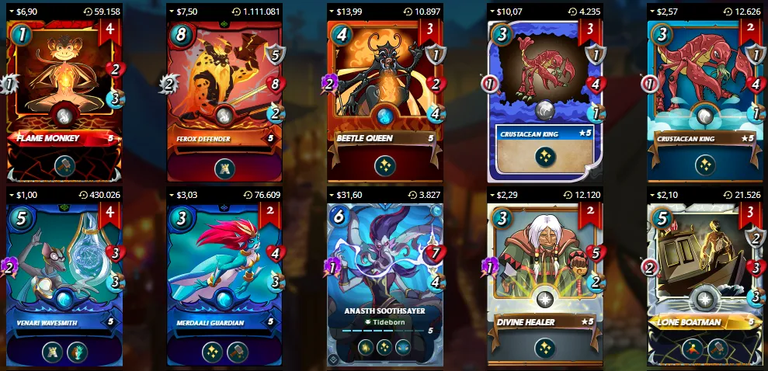
One way to build your team after choosing a tank is to focus the composition around the tank, as the team's main card. To do this, you should consider forming protection for the tank, such as a healer who will heal the damage taken, but also units that provide extra defenses such as protect and repair to add a shield, add health with Strength, or increase speed with Swiftness. However, this strategy has a weakness: an Opportunity composition. If your supports are fragile, if the enemy chooses Opportunity monsters, they will be quickly eliminated and the tank will fall soon after.
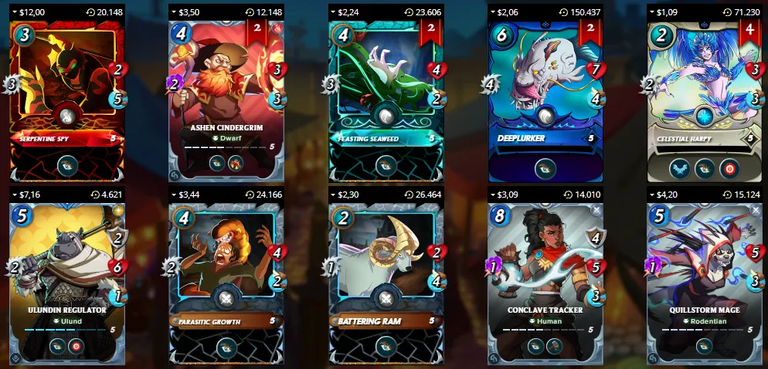
It's precisely from this weakness of the previous strategy that another possible strategy emerges for Fog of War. It maintains the core of choosing a good Tank for your team, but instead of running the composition with resources for the Tank, it will be used only to hold out as long as possible, while the protagonists with Opportunity completely defeat the enemy team. These two strategies are like two sides of the same coin: you either win in protection or in attack; whoever makes the best choices wins.
Example Match with Fog of War

Among the three rule possibilities available in the Rumble Ruleset, the rule that appeared in a recent match was Fog of War. Previously, two strategies that are commonly used when this rule is available were mentioned, with the common thread being A good tank. Now we'll see this applied in practice in this 50-mana match, with three elements available (fire, water, and life). In addition to the Fog of War, there was also an amplify, which, by the way, ended up not being used much by either team.
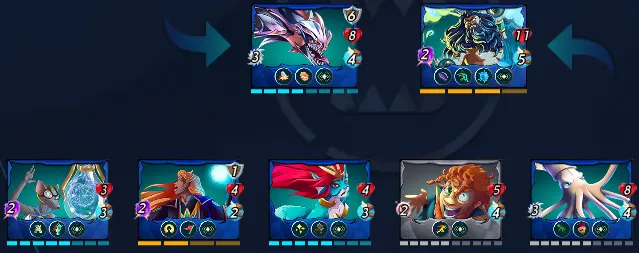
The strategy for both sides was to focus on the tank. On my team, the choice was Djinn Oshannus, who has a great speed of 5, a considerable HP of 11, magic damage, and protection against magic damage with his Void. There was a greater focus on Speed, with Kelya's +1 and Supply Runner's +1 Swiftness. Furthermore, to make up the rest of the more defensive composition, we have Merdaali Guardian, guaranteeing healing for the tank and also repairing armor, which Kelya will provide +1, along with Vernari Wavesmith, which will add +2 armor for everyone. The idea here is to help the tank, but also protect the other cards from a potential Opportunity. Finally, River Hellondale provides +1 melee damage for the Flying Squid and also revives a support unit or the tank. Finally, the Flying Squid provides damage and assumes the role of second tank, but helps with the Djinn's blind to avoid further attacks.
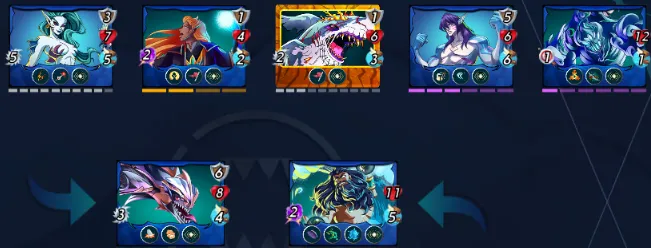
On the enemy team's side, the main objective was to improve the damage of the tank DiemonShark and the off-tank Coastal Sentry with the +1 from River and +1 from Demented Shark. Luckily, I had plenty of armor and repair. Their strategy was to eliminate my tank while the Wave Brood held off all attacks with Taunt.


O Splinterlands realiza toda semana um evento chamado Community Engagement Challenge, que tem o objetivo de fazer com que os jogadores desse jogo de cartas nft, comentem sobre um determinado assunto, compartilhando a sua visão com o restante da comunidade. Nessa semana temos como tema o #RulesetRumble que diferente dos eventos passados que abordava uma ruleset específica, nesse o jogador poderá escolher entre: Fog of War, Little League ou Up Close & Personal.
Vamos abordar detalhes da estratégia utilizada na regra Fog of War, que foi a escolhida para esse evento e em seguida um exemplo prático de uma partida com essa regra, analisando o meu time e o do oponente. Venha descobrir tudo agora!
Fico agradecido se você puder dar um Upvote, Reblogs ou algum Tips ( PIZZA 🍕, PGM 🎮, LOLZ 😆, ALIVE ❤️, etc ). Obrigado e boa leitura! 🍀

[VERSÃO PORTUGUÊS]
Estratégia x Fog of War

Como contextualização inicial, devemos entender a fundo o que é a ruleset “Fog of War”. Quando essa regra está ativa na partida, todos os monstros com Sneak e Snipe perdem essas habilidades, permanecendo apenas monstros com Opportunity como uma ameaça a ser considerada. Ao se deparar com a situação em que essa ruleset aparecer, como a aparição de monstros que atacam a backline ou o meio do time é drasticamente reduzida, a melhor estratégia para o jogador é escolher um ótimo tank, gastar mana suficiente para adicionar na lineup um tank capaz de suportar uma boa quantidade e também variedade de dano (melee, ranged e mágico), porque os ataques serão concentrados em grande parte na frontline do seu time.

Uma das formas de montar o seu time depois da escolha do tank é direcionar a composição justamente para rodar em torno do tank, como a carta principal do time. Para isso, você deve pensar em formar de proteção para ele como um healer que vá ficar curando o dano sofrido, mas também unidades que garantam defesas extras como protect e repair para adicionar um shield, adicionar vida com Strenght, ou subir a velocidade com Swiftness. Entretanto, essa estratégia tem uma fraqueza que é uma composição de Opportunity, caso os seus suportes sejam frágeis, se o inimigo escolher monstros com opportunity eles serão rapidamente eliminados e o tank cairá em seguida.

Justamente nessa fraqueza da estratégia anterior que surge outra estratégia possível de ser usada no Fog of War. Mantém o core de escolher um bom Tank para o seu time, mas em vez de rodar a composição com recursos para o Tank, ele será usado apenas para aguentar o máximo de tempo possível, enquanto os protagonistas com Opportunity derrotam o time inimigo por completo. Essas duas estratégias são como duas faces da mesma moeda, ou você ganha na proteção ou no ataque, que fizer as melhores escolhas vence.
Exemplo de Partida com Fog of War

Dentre as 3 possibilidades de regras disponíveis no Ruleset Rumble a regra que aconteceu em uma partida recente foi justamente a Fog of War. Anteriormente foi mencionado duas estratégias que são geralmente usadas quando temos essa regra disponível, com o ponto em comum sendo um bom tank. Agora veremos isso aplicado na prática nessa partida de 50 de mana, com 3 elementos disponíveis (fogo, água e vida). Além do Fog of War havia também um amplificar, que por sinal acabou não sendo tão usado por nenhum dos times.

A estratégia dos dois lados foi dar um foco no Tank. No meu time a escolha foi Djinn Oshannus, que tem uma ótima speed de 5, um HP considerável de 11, dano mágico e uma proteção contra dano mágico com seu Void. Houve um foco maior na Speed com +1 da Kelya e também +1 do Swiftness do Supply Runner. Além disso, para compor o restante da composição mais defensiva, temos a Merdaali Guardian, garantindo a cura no Tank e também reparando a armadura, que a Kelya vai fornecer +1 junto da Vernari Wavesmith que vai adicionar +2 de armor para todos. Aqui a ideia é ajudar o tank, mas também proteger as demais cartas de um possível Opportunity. Por fim, o River Hellondale vem dar +1 de melee para o Flying Squid e também ressuscitar alguma unidade supporte ou o tank. Por fim, o Flying Squid ajuda no dano e assumindo a função de segundo tank, mas ajuda com o blind ao Djinn evitar ainda mais ataques.

Do lado do time inimigo o grande objetivo era melhorar o dano do tank DiemonShark e do off-tank Coastral Sentry com o +1 do River e +1 do Demented Shark. Por sorte eu tinha bastante armor e repair. A estratégia dele era eliminar o meu tank enquanto o Wave Brood segurava todos os ataques com o Taunt.


If you like Crypto, Play2Earn, Finance or Anime content, consider FOLLOW me, that way you'll receive a notification when new post is done.
Thank you for reading. See ya! 👋👋

What are the strategies you guys use in Fog of War?
Obrigado por promover a comunidade Hive-BR em suas postagens.
Vamos seguir fortalecendo a Hive
Sending you Ecency curation votes.😉

Thanks :D
Delegate Tokens and HP to Fallen Angels to earn weekly rewards!
Delegate | Join to the guild
Thanks.
Thanks for sharing! - @lenonmc21
